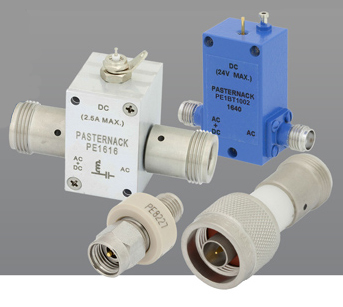Bias Tees and DC blocks are both low frequency filters designed to pass certain wanted signals and power rails while blocking other signals and limiting the performance impact on RF/microwave circuits. Bias Tees are essentially diplexers with an extremely low crossover frequency, and DC blocks are high pass filters with cutoff frequency down to audio frequencies and DC.
DC blocks are used for enhancing signal-to-noise ratio and dynamic range on some very low frequency or wideband systems, as well as block DC and audio frequencies from testing that may require isolation from such low frequency components. DC blocks are also used for signal source modulation leakage suppression, and ground loop elimination.
Bias Tees are used to allow for DC currents and/or voltages to pass to RF devices while blocking RF/microwave signals on the same line. For example, a Bias Tee may be used to enable a power supply to a transistor or amplifier circuit, which requires a DC signal and would be disturbed by the RF content on the signal and power line. There are also pulsed bias tees, which allow for minimum distortion on current, or voltage, pulses for amplifiers and devices which require intermittent signals for biasing or power.
Bias Tees and DC blocks are both very commonly used in many RF/microwave circuits which require the conveyance of DC signals along the same coaxial or microstrip signal path as RF/microwave signals. Bias tees and DC blocks may even be used together at a node where the DC power or bias voltage/current is needed, but would be disruptive if it passed further down the RF transmission line.
Bias tees are used anywhere from cell phone amplifiers to test and measurement equipment. An example of this is with powered probes which have a power hookup at the same port as the RF signal port.
DC blocks are typically only used where powered RF transmission lines, or “hot” conductors, are used. However, DC blocks may also be used to separate a circuit from a ground place and DC and audio signals, to prevent current passing or voltage developing from that circuit node to ground. An example of this is in the instance where a voltage is injected into the source of a shunt FET, which is also grounded to the grounded housing or fixture of the assembly.

